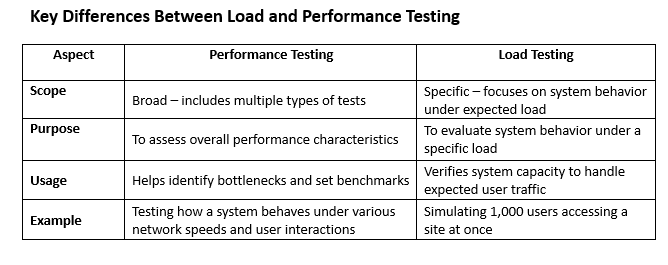Difference Between Load Testing and Performance Testing
In today’s competitive digital landscape, delivering a high-performing application is no longer optional—it’s essential. To ensure software applications meet user expectations under various conditions, organizations rely on performance evaluation methods such as load testing and performance testing. While these terms are often used interchangeably, they serve distinct purposes. Understanding the difference between load and performance testing can help businesses make informed decisions, especially when partnering with a performance testing company or using professional performance testing services. What is Performance Testing? Performance testing is a broad term that encompasses all types of tests that assess how an application behaves under different conditions. The main goal is to determine the speed, responsiveness, scalability, and stability of a system. Performance testing includes several subtypes: •Load Testing •Stress Testing •Scalability Testing •Soak Testing (Endurance Testing) Each of these serves a unique purpose, but together, they give a holistic view of an application’s performance. What is Load Testing? Load testing is a subset of performance testing. Its primary objective is to measure how the system handles a specific expected load. This could mean a certain number of users accessing the system simultaneously or performing a high volume of transactions at once. For example, if an e-commerce website expects 10,000 users during a Black Friday sale, a load test would simulate those conditions to ensure the site performs efficiently under that load. Key Metrics in Load Testing: •Response time •Throughput •Resource utilization (CPU, memory, etc.) •Error rates under expected load Why These Tests Matter Both performance and load testing are critical for ensuring a positive user experience. Applications that crash or slow down under user load can damage a company’s reputation, lead to revenue loss, and reduce user retention. That’s why businesses often rely on performance testing services provided by experienced professionals. Role of a Performance Testing Company A performance testing company specializes in evaluating and enhancing the performance of applications. These companies employ skilled engineers, proven methodologies, and powerful tools to simulate real-world conditions and identify areas for improvement. Here’s how a performance testing company adds value: •Expertise: They have deep knowledge of tools like JMeter, LoadRunner, and Gatling. •Customization: They tailor tests based on the business model, traffic expectations, and infrastructure. •Analysis and Reporting: They offer detailed reports with actionable insights. •Scalability Planning: Help determine how your system will scale with growing traffic and usage demands. Benefits of Performance Testing Services Outsourcing to a trusted provider of performance testing services ensures: •Early detection of performance issues •Optimized resource usage •Better preparedness for peak traffic •Enhanced user satisfaction and trust In an age where speed and stability are critical, performance testing services help companies stay competitive and resilient. Conclusion Understanding the distinction between load testing and performance testing is vital for effective software quality assurance. While performance testing provides a broad overview of system behavior, load testing zooms in on how the system copes with expected user demands. Whether you’re preparing for a high-traffic event, launching a new application, or simply want to enhance your system’s performance, partnering with a specialized performance testing company can make a significant difference. Their performance testing services not only ensure stability and speed but also help deliver a seamless user experience in all scenarios.

In today’s competitive digital landscape, delivering a high-performing application is no longer optional—it’s essential. To ensure software applications meet user expectations under various conditions, organizations rely on performance evaluation methods such as load testing and performance testing. While these terms are often used interchangeably, they serve distinct purposes.
Understanding the difference between load and performance testing can help businesses make informed decisions, especially when partnering with a performance testing company or using professional performance testing services.
What is Performance Testing?
Performance testing is a broad term that encompasses all types of tests that assess how an application behaves under different conditions. The main goal is to determine the speed, responsiveness, scalability, and stability of a system.
Performance testing includes several subtypes:
•Load Testing
•Stress Testing
•Scalability Testing
•Soak Testing (Endurance Testing)
Each of these serves a unique purpose, but together, they give a holistic view of an application’s performance.
What is Load Testing?
Load testing is a subset of performance testing. Its primary objective is to measure how the system handles a specific expected load. This could mean a certain number of users accessing the system simultaneously or performing a high volume of transactions at once.
For example, if an e-commerce website expects 10,000 users during a Black Friday sale, a load test would simulate those conditions to ensure the site performs efficiently under that load.
Key Metrics in Load Testing:
•Response time
•Throughput
•Resource utilization (CPU, memory, etc.)
•Error rates under expected load
Why These Tests Matter
Both performance and load testing are critical for ensuring a positive user experience. Applications that crash or slow down under user load can damage a company’s reputation, lead to revenue loss, and reduce user retention. That’s why businesses often rely on performance testing services provided by experienced professionals.
Role of a Performance Testing Company
A performance testing company specializes in evaluating and enhancing the performance of applications. These companies employ skilled engineers, proven methodologies, and powerful tools to simulate real-world conditions and identify areas for improvement.
Here’s how a performance testing company adds value:
•Expertise: They have deep knowledge of tools like JMeter, LoadRunner, and Gatling.
•Customization: They tailor tests based on the business model, traffic expectations, and infrastructure.
•Analysis and Reporting: They offer detailed reports with actionable insights.
•Scalability Planning: Help determine how your system will scale with growing traffic and usage demands.
Benefits of Performance Testing Services
Outsourcing to a trusted provider of performance testing services ensures:
•Early detection of performance issues
•Optimized resource usage
•Better preparedness for peak traffic
•Enhanced user satisfaction and trust
In an age where speed and stability are critical, performance testing services help companies stay competitive and resilient.
Conclusion
Understanding the distinction between load testing and performance testing is vital for effective software quality assurance. While performance testing provides a broad overview of system behavior, load testing zooms in on how the system copes with expected user demands.
Whether you’re preparing for a high-traffic event, launching a new application, or simply want to enhance your system’s performance, partnering with a specialized performance testing company can make a significant difference.
Their performance testing services not only ensure stability and speed but also help deliver a seamless user experience in all scenarios.


.jpg)

























![[Webinar] AI Is Already Inside Your SaaS Stack — Learn How to Prevent the Next Silent Breach](https://blogger.googleusercontent.com/img/b/R29vZ2xl/AVvXsEiOWn65wd33dg2uO99NrtKbpYLfcepwOLidQDMls0HXKlA91k6HURluRA4WXgJRAZldEe1VReMQZyyYt1PgnoAn5JPpILsWlXIzmrBSs_TBoyPwO7hZrWouBg2-O3mdeoeSGY-l9_bsZB7vbpKjTSvG93zNytjxgTaMPqo9iq9Z5pGa05CJOs9uXpwHFT4/s1600/ai-cyber.jpg?#)












































































































































![[The AI Show Episode 144]: ChatGPT’s New Memory, Shopify CEO’s Leaked “AI First” Memo, Google Cloud Next Releases, o3 and o4-mini Coming Soon & Llama 4’s Rocky Launch](https://www.marketingaiinstitute.com/hubfs/ep%20144%20cover.png)





























































































































![[FREE EBOOKS] Machine Learning Hero, AI-Assisted Programming for Web and Machine Learning & Four More Best Selling Titles](https://www.javacodegeeks.com/wp-content/uploads/2012/12/jcg-logo.jpg)








































































![Rogue Company Elite tier list of best characters [April 2025]](https://media.pocketgamer.com/artwork/na-33136-1657102075/rogue-company-ios-android-tier-cover.jpg?#)








































































_Andreas_Prott_Alamy.jpg?width=1280&auto=webp&quality=80&disable=upscale#)






























































































![What’s new in Android’s April 2025 Google System Updates [U: 4/18]](https://i0.wp.com/9to5google.com/wp-content/uploads/sites/4/2025/01/google-play-services-3.jpg?resize=1200%2C628&quality=82&strip=all&ssl=1)










![Apple Watch Series 10 Back On Sale for $299! [Lowest Price Ever]](https://www.iclarified.com/images/news/96657/96657/96657-640.jpg)
![EU Postpones Apple App Store Fines Amid Tariff Negotiations [Report]](https://www.iclarified.com/images/news/97068/97068/97068-640.jpg)
![Apple Slips to Fifth in China's Smartphone Market with 9% Decline [Report]](https://www.iclarified.com/images/news/97065/97065/97065-640.jpg)
































































































































